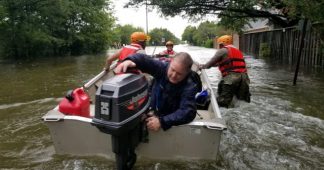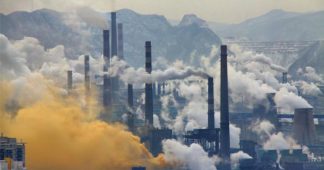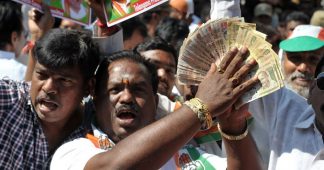Over 1200 people have been killed in rains that have inundated a third of Bangladesh along with portion of India, Nepal and Pakistan
Source: The Real News / The Dawn News / September 1, 2017
Jaisal Noor: As the devastation of Hurricane Harvey dominates the airwaves, another massive flooding event is happening across Southeast Asia, leaving two thirds of Bangladesh under water, according to Oxfam. Flooding has inundated eastern India to Mumbai, Karachi, Pakistan and Nepal. 41 million people have been affected, with the death toll at 1200 and rising. Rescuers in the Indian city of Mumbai wound down on Friday their search for victims in the ruins of a condemned building that collapsed, after pulling 12 survivors and 34 bodies from the rubble, emergency services said. The 117-year-old, six story building in a congested old neighborhood came crashing down early on Thursday after heavy rain had drenched the financial hub for days. Among the dead was a 20-[year]-old baby, police said. Of the 46 people pulled out, 33 were dead.Meanwhile, floods triggered by torrential rain in India’s eastern Bihar province wreaked havoc on Thursday, inundating large swaths of land, destroying crops and affecting thousands of people. Government officials said at least 514 people have been killed in the worst monsoon floods in years, with thousands sheltered in relief camps away from their inundated homes. Large cities were underwater on Thursday following the overflow of water in the Tirhut canal. Days of flooding have also destroyed standing crops. Last week, Indian Prime Minister Narendra Modi reviewed the flood situation in Bihar and announced a relief package of five billion rupees, equivalent to about 78 million U.S. dollars, following a meeting with local officials.Life gradually returned to normal in Pakistan’s largest city, Karachi, on Friday, a day after 13 people were killed by flooding following heavy monsoon rains, which hit the sprawling metropolis. The deaths were the latest in a disaster that has so far killed more than 1,200 people across the region, encompassing India, Bangladesh and Nepal. The private Edhi Foundation, which runs ambulances and medical centers has said that 350 to 400 in low rising areas were inundated near the Lyari river. Countries in the region suffer frequent flooding during the June to September monsoon season, but international aide agencies said the damage has been worse than usual this year.To talk about the links between climate change and what could be done about, we reached Neha Khandekar, from The Center for Global Environmental Research.Neha Khandekar: Talking about the impact of flooding, I think residing in a metropolitan city, myself, and traveling in a few others, I have seen the cities collapsing in the event of extreme rainfall and that’s because of a lot of water logging that happens. The transportation comes to a halt, one has to wade their back home or to get to their destination within these water logged roads full of storm water, which could be unhealthy for your own skin.It’s difficult because if you have to go and pick up your kids or if you have a medical emergency in such situations, then all the more difficult.Jaisal Noor: In predominantly agricultural areas of South Asia, Typhoons are not rare and floods are not a total surprise like they’ve been in Texas, for example. In what ways is this unusual? Why are the local populations and governments not better equipped to deal with this?Neha Khandekar: The flood events or typhoons have been happening in South Asia, but what leaves us unprepared … well, why is it difficult to deal with these events is probably because the early warning systems not being robust and even if the warnings are being released by the meteorological department then probably the dissemination is not up to the mark. It could be better and the local citizens could be made more aware to deal with such flooding, which could be done by the disaster management department, which there are examples of how they dealt with typhoons in a better way and they evacuated everyone in case of flooding. Something like that could be a role model and could be adopted for definite other cases.Then there are storm water drains and sewage drains, which are not designed to deal with the organically growing urban areas in South Asian region. These areas are growing because of lack of livelihood opportunities back in the villages, and it’s really unforeseen.Not just the design, but even the maintenance and the regular cleaning and not dumping any garbage in the storm water drain so that they don’t get clogged. These sort of things have to be looked into and done on a frequent basis and not just at the time of the flood and then you have to forget about it.Jaisal Noor: In the United States, there’s been a concerted effort to undermine climate science and a large number of Americans doubt that climate change is behind these extreme weather events we’re facing in the US and across the world. Talk about what the situation is in Southeast Asia. Do people see the link between these extreme weather events and climate change?Neha Khandekar: Based on the perception … there are perception based studies that the researchers do collect the understanding of local citizens about the changes that they have observed in their lifetimes or in a span of two to three generations. What I have seen out of such reports and out of the studies that even I have conducted or my team members have conducted that people do feel the change in the climate and when they see such extreme events happening within a short duration or reducing number of rainy days unforeseen.Some people call it directly by the name of climate change, some people are not aware of it, but they do tell us it something unforeseen. This is something that they or their forefathers have not seen happening in their lifetime.











